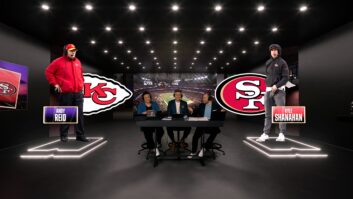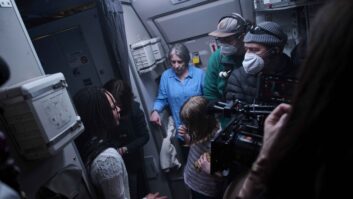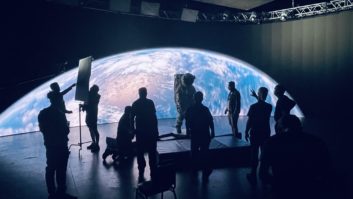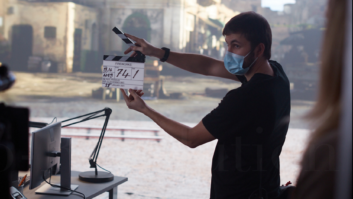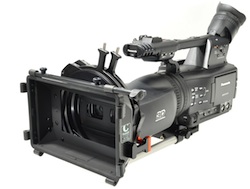
Generally, a 3D camera is a pair of 2D cameras combined in a 3D rig. However, the first integrated twin-lens 3D cameras have emerged, making 3D more practical and offering the prospect of 3D production without the need for a stereographer, convergence operator and 3D engineer. David Fox reports.
So far, Panasonic, 3D One, Frontniche and Sony have released or announced integrated 3D cameras, with Panasonic’s AG-3DA1 in widest use. It is limited compared to a full 3D rig, in that it copes best with subjects that are between about 2m to 10m away, as it has a fixed inter-axial distance (between the centre of each lens), so you can’t move the lenses to give a better 3D effect for extreme close ups (anything less than about 1m for this camera) or for wide landscapes.
But then, the €16,800 AG-3DA1 (above, with Chrosziel MatteBox) is not intended for that kind of work, no more than it is designed for cinema productions. The lenses are just about the right distance apart for television use. One problem with 3D is that you have to think about how you will deliver when you create. So, a movie that is meant to be shown on a big screen has to be remastered for the TV so that the parallax is correct for viewers’ living rooms.
Weighing less than 3kg, Panasonic’s camera is certainly a great deal lighter than a typical 3D rig, and appears to be relatively easy to operate. However, if you are going to control your own convergence, it will take a lot of experience to do so accurately with a single small viewfinder or LCD screen. It would probably be better to link it to a larger screen, with a convergence operator (it can be set remotely via two HD-SDI wireless links, or cables if you’re in a studio or OB set up), but that removes some of the portability and simplicity of using a camcorder.
The other approach is to set the convergence at a conservative level before you start shooting and then tweak it in post, which makes operation barely more difficult than a conventional camcorder, as it automatically corrects horizontal and vertical displacement.
Accessories makers are already offering add-on products for the AG-3DA1, including a remote convergence controller, similar to a thumb-operated zoom or focus controller, from Bebob, and support and matteboxes from Chrosziel.
First One
3D One had the first integrated 3D camcorder to start shipping, and uses a novel design: 3D at both ends, with twin lenses and twin viewfinders. It has been designed to prevent users from shooting bad 3D.
With normal 3D rigs, it is very easy to go out of alignment, something the integrated camcorder won’t do — but 3D One has taken this further by not allowing users to go negative, as it’s a completely parallel system. “It’s very easy to make bad 3D, which is what we want to prevent,” says Marcelo Ackermann, development and marketing support, 3D One. “This is the most foolproof 3D camera that there is. You set it down, you press record, you stop, and you have your file recorded properly.”
The lenses are 65mm apart (or 55m on request), and users can see stereo through the twin viewfinders (which seem simple to align – there are zoom, vergence and focus controls). It sells at €39,500, and is also available to rent. The Dutch company does a lot of 3D work for the European Space Agency, and the camera has also been used to cover sailing events in Amsterdam. The latest version, the CP31, weighs 4kg, records 1080p at 24, 25 and 30fps 4:2:0 to an internal, swappable 2.5-inch drive, and has two HDMI outputs to record 1080p at 48, 50 or 60fps 4:4:4.
In Front
The Frontniche VC-3100 HD looks just like a sleek version of a conventional OB camera, but with twin lenses and two sets of 2/3-inch 3CCD sensors. It is an Ortho-Stereoscopic camera manufactured by V3i, and can be used for 3D without the need for a convergence operator. It offers automatic zoom, focus, horizontal axis and moving sensor control, using a variety of patented processes.
It boasts a “maximum 3D effect distance” of 360m, which is useful for sports, no 3D distortion (keystone or geometric), no rolling or vertical misalignment, and adjustable/automatic separation distance between lenses for 3D depth effect.
It is available in 1080i at 50 or 60fps, or an optional 3G version at 1080p, and uses two 18x zoom lenses with synchronised zoom, focus and iris. The lenses are parallel, but the image sensors are moved outwards while converging, which avoids keystoning.
Coming soon?
At the time of writing, not much has been revealed about Sony’s integrated 3D camcorder. It will be a shoulder-mounted design, which Sony believes will make it easier to keep stable (something that is important for 3D as any wobbles are much more noticeable – jerky 3D looks unnatural and can cause nausea).
At IBC Olivier Bovis, Audiovisual Media director, Sony Professional, said that it was likely to be based on half-inch CMOS sensors (six per camera), but they were also considering the use of CCDs or 2/3-inch sensors, although it was unlikely to use 1/3-inch imagers. The prototype it showed used SxS cards, but it hadn’t then settled on the codec or recording media. Indeed, even the eventual release date was unknown, except that it should be during 2011. “Making 3D is easy. Making good 3D is not something that comes out of the blue,” he said.
Of course, Sony has considerable experience in 3D from the use of its cameras, 3D processors and infrastructure for events such as the World Cup and Ryder Cup. The golf was the biggest ever live 3D production, with 20 3D camera rigs at the Celtic Manor course, plus Sony’s MPE-200 3D processor converting some of the 2D studio feeds into live 3D. The rigs were fitted with Sony HDC-1500R cameras, with twelve 3ality Digital rigs, four Element Technica rigs, and four specially designed wireless 3D camera rigs from Presteigne Charter.
Because the course is the largest venue used for 3D, needing cabling to cover some 32km, with both fixed and moving cameras, Sony had to develop additional technology – the HDFA-200 optical fibre transmission adapter/combiner, which enable a pair of 3D cameras to send their signals down a single fibre, reducing the amount of fibre required and making rigging a little easier.
Unlike football where the cameras are fixed, many more rigs were needed to cover the course. “The HDFA-200 optical fibre adaptor has been revolutionary as it has enabled us to build a solution of this scale that otherwise would not have been possible,” explains Mark Grinyer, 3D Sports Solutions business head, Sony Professional.
Raw 3D
An alternative to the integrated camcorder is a small, modular 3D system, such as that from Vienna-based IndieCam. It uses tiny 1080p 50/60 cameras that output a 10-bit RAW file, using Adobe’s Cinema DNG format. The initial system uses single 2/3-inch CCD sensors that produce a 12-bit signal, going through an in-camera look-up table, which means it is not just a linear translation, so it can retain more of the 12-bit quality. It can also output YUV 4:2:2.
The small cameras mean the rig could have an interaxial distance of just 40mm (although that depends on the size of the C-mount lenses used).
It is also developing its own Shuttle recorder that can record the RAW files and act as a camera controller. The Shuttle has two HD-SDI inputs, and multiple power outputs, for monitors, etc., but IndieCam has also designed a remote control system for it, which would give users the option of recording on another HD-SDI recorder, such as Convergent Design’s nano3D. “It is not necessary to use the camera heads with our Indie Shuttle system,” says Peter Niklas, software and hardware development.
Camera aids include histograms or zebra stripes, and it can create anaglyph previews on its 7-inch monitor. The LCD is sunlight readable and will come in DVI or SDI versions.
The full system is expected to cost less than €40,000. Although the camera heads are available now, in limited quantities, the recorder and controller will probably not be ready until NAB. The remote control should be available by now. The system has been used on a few projects so far, including one multicam shoot with 12 3D rigs.
www.3d-one.com
www.frontniche.com
indiecam.com
www.panasonic-broadcast.com
www.sonybiz.net
